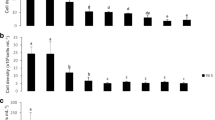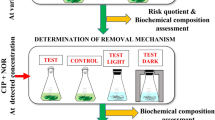Abstract
In this study, we assessed the effects of 11-day exposure of sulfadiazine (SD), sulfamethazine (SM2), norfloxacin (NOR), and enrofloxacin (ENR) on the growth, chlorophyll a (Chl. a) content, phycobiliproteins (PBPs) content, and alkaline phosphatase (ALP) activity of Chrysosporum ovalisporum, examined the removal rate of these antibiotics by C. ovalisporum, and performed acute toxicology test with Daphnia magna to determine the effect of interaction between antibiotics and cyanobacteria on aquatic animals. The results showed that the stress of SD and SM2 increased extracellular ALP activity and weakly inhibited the algal growth and the contents of Chl. a and PBPs compared with that noted in the control. ENR and NOR treatment groups exerted significant inhibition on algal growth as well as Chl. a and PBPs contents and ALP activity, although the cyanobacterium could degrade these two antibiotics more than SD and SM2. The results also revealed that the interaction between antibiotics and cyanobacteria could inhibit D. magna feeding.






Similar content being viewed by others
References
Ashouri S, Keyvanshokooh S, Salati AP, Johari SA, Pasha-Zanoosi H (2015) Effects of different levels of dietary selenium nanoparticles on growth performance, muscle composition, blood biochemical profiles and antioxidant status of common carp (Cyprinus carpio). Aquaculture 446:25–29
Bai L, Zhao Z, Wang C, Wang C, Liu X, Jiang H (2017) Multi-spectroscopic investigation on the complexation of tetracycline with dissolved organic matter derived from algae and macrophyte. Chemosphere 187:421–429
Bai Z, Ren T, Han Y, Rahman MM, Hu Y, Li Z, Jiang Z (2018) Influences of dietary selenomethionine exposure on tissue accumulation, blood biochemical profiles, gene expression and intestinal microbiota of Carassius auratus. Comp Biochem Physiol C Toxicol Pharmacol 218:21–29
Bayramoğlu G, Arica MY (2008) Removal of heavy mercury (II), cadmium (II) and zinc (II) metal ions by live and heat inactivated Lentinus edodes pellets. Chem Eng J 143(1–3):133–140
Bennett A, Bogorad L (1973) Complementary chromatic adaptation in a filamentous blue-green alga. J Cell Biol 58(2):419–435
Brain RA, Hanson ML, Solomon KR, Brooks BW (2008) Aquatic plants exposed to pharmaceuticals: effects and risks. Rev Environ Contam Toxicol 192:67–115
Brand LE, Pablo J, Compton A, Hammerschlag N, Mash DC (2010) Cyanobacterial blooms and the occurrence of the neurotoxin β-N-methylamino-L-alanine (BMAA) in South Florida aquatic food webs. Harmful Algae 9(6):620–635
Brenes-Guillén L, Fuentes-Schweizer P, García-Piñeres A, Uribe-Lorío L (2019) Tolerance and sorption of bromacil and paraquat by thermophilic cyanobacteria Leptolyngbya 7M from Costa Rican thermal springs. J Contam Hydrol 226:103539
Bu QW, Wang B, Huang J, Liu K, Deng SB, Wang YJ, Gang Y (2016) Estimating the use of antibiotics for humans across China. Chemosphere 144:1384–1390
Cao CC (2018) Interactions of cyanobacterical blooms-derived dissolved organic matter and antibiotics. Dissertation, Southeast University
Chen S, Zhang W, Li JY, Yuan MZ, Zhang JH, Xu F, Xu HT, Zheng XY, Wang LQ (2020) Ecotoxicological effects of sulfonamides and fluoroquinolones and their removal by a green alga (Chlorella vulgaris) and a cyanobacterium (Chrysosporum ovalisporum). Environ Pollut 263:114554
Chen T, Li YW, Mo CH, Gao P, Wu XL, Qu XL (2010) Screening of sulfonamide and fluroquinolone antibiotics in wastewater of sewage treatment plants in Guangzhou. South China. Environ Sci Technol 33(6):144-147+180
Crawford A, Holliday J, Merrick C, Brayan J, van Asten M, Bowling L (2017) Use of three monitoring approaches to manage a major Chrysosporum ovalisporum bloom in the Murray River, Australia, 2016. Environ Monit Assess 189(4):202
Cui JS, Qi CY, Liu XJ (2012) Study on response rule of the Microcystis aeruginosa fluorescence on the biological toxicity of HgCl2. Meteorol Environ Res 3(10):20-22+26
De Philippis R, Colica G, Micheletti E (2011) Exopolysaccharide-producing cyanobacteria in heavy metal removal from water: molecular basis and practical applicability of the biosorption process. Appl Microbiol Biotechnol 92:697–708
Defoirdt T, Sorgeloos P, Bossier P (2011) Alternatives to antibiotics for control of bacterial disease in aquaculture. Curr Opin Microbiol 14(3):251–258
Dhanaraj PS, Kumar S, Lal R (1989) Bioconcentration and metabolism of aldrin and phorate by the blue-green algae Anabaena (ARM 310) and Aulosira fertilissima (ARM 68). Agric Ecosyst Environ 25(2–3):187–193
Doshi H, Ray A, Kothari IL (2007) Biosorption of cadmium by live and dead Spirulina: IR spectroscopic, kinetics, and SEM studies. Curr Microbiol 54(3):213–218
Ebert I, Bachmann J, Kühnen U, Küster A, Kussatz C, Maletzki D, Schlüter C (2011) Toxicity of the fluoroquinolone antibiotics enrofloxacin and ciprofloxacin to photoautotrophic aquatic organisms. Environ Toxicol Chem 30(12):2786–2792
El-Sheekh MM, Hamouda RA (2014) Biodegradation of crude oil by some cyanobacteria under heterotrophic conditions. Desalin Water Treat 52(7–9):1448–1454
González-Pleiter M, Gonzalo S, Rodea-Palomares I, Leganés F, Rosal R, Boltes K, Marco E, Fernández-Piñas F (2013) Toxicity of five antibiotics and their mixtures towards photosynthetic aquatic organisms: implications for environmental risk assessment. Water Res 47(6):2050–2064
Guo JS, Chen Y, Li Z, Fang F, Sun ZY, Chen YB (2011) Seasonal variation of chlorophyll a and its potential relationship with various algal species in Xiaojiang River backwater area. Three Gorges Reservoir Huanjing Kexue 32(4):976–981
Hong YW, Yuan DX, Lin QM, Yang TL (2008) Accumulation and biodegradation of phenanthrene and fluoranthene by the algae enriched from a mangrove aquatic ecosystem. Mar Pollut Bull 56(8):1400–1405
Humpage AR, Rositano J, Bretag A, Brown R, Baker PD, Nicholson BC, Steffensen DA (1994) Paralytic shellfish poisons from Australian cyanobacterial blooms. Mar Freshwater Res 45(5):761–771
Ihlenfeldt MJ, Gibson J (1975) Phosphate utilization and alkaline phosphatase activity in Anacystis nidulans (Synechococcus). Arch Microbiol 102(1):23–28
Ilhan ZE (2010) Fate of agrochemicals in wood chip denitrifying reactors and their impacts on wood chip microbial ecology. Dissertation, Iowa State University
Jia W, Huang X, Li C (2014) A preliminary study of the algicidal mechanism of bioactive metabolites of Brevibacillus laterosporus on Oscillatoria in prawn ponds. Sci World J 2014:869149
Klein EY, Van Boeckel TP, Martinez EM, Pant S, Gandra S, Levin SA, Goossens H, Laxminarayan R (2018) Global increase and geographic convergence in antibiotic consumption between 2000 and 2015. Proc Natl Acad Sci USA 115(15):E3463–E3470
Kraemer SA, Ramachandran A, Perron GG (2019) Antibiotic pollution in the environment: from microbial ecology to public policy. Microorganisms 7:180
Kumar S, Lal R, Bhatnagar P (1988) Uptake of dieldrin, dimethoate and permethrin by cyanobacteria, Anabaena sp. and Aulosira fertilissima. Environ Pollut 54(1):55–61
Lal S, Lal R, Saxena DM (1987) Bioconcentration and metabolism of DDT, fenitrothion and chlorpyrifos by the blue-green algae Anabaena sp. and Aulosira fertilissima. Environ Pollut 46(3):187–196
Li W, Shi Y, Gao L, Liu J, Cai Y (2012) Occurrence of antibiotics in water, sediments, aquatic plants, and animals from Baiyangdian Lake in North China. Chemosphere 89(11):1307–1315
Liu B, Liu W, Nie X, Guan C, Yang Y, Wang Z, Liao W (2011) Growth response and toxic effects of three antibiotics on Selenastrum capricornutum evaluated by photosynthetic rate and chlorophyll biosynthesis. J Environ Sci 23(9):1558–1563
Loftsson T, Konrádsdóttir F, Másson M (2006) Influence of aqueous diffusion layer on passive drug diffusion from aqueous cyclodextrin solutions through biological membranes. Pharmazie 61(2):83–89
Lopez CB, Jewett EB, Dortch Q, Walton BT, Hudnell HK (2008) Scientific assessment of freshwater harmful algal blooms. In: Interagency Working Group on Harmful Algal Blooms, Hypoxia, and Human Health of the Joint Subcommittee on Ocean Science and Technology. Washington, DC
Martinez JL (2009) Environmental pollution by antibiotics and by antibiotic resistance determinants. Environ Pollut 157(11):2893–2902
Mcmanus PS, Stockwell VO, Sundin GW, Jone AL (2002) Antibiotic use in plant agriculture. Annu Rev Phytopathol 40(1):443–465
Mulholland MR, Floge S, Carpenter EJ, Capone DG (2002) Phosphorus dynamics in cultures and natural populations of Trichodesmium spp. Mar Ecol Prog Ser 239:45–55
Nakajima Y, Ueda R (1999) Improvement of microalgal photosynthetic productivity by reducing the content of light harvesting pigment. J Appl Phycol 11(2):195–201
OECD (2004) OECD 202: Daphina sp. acute immobilisation test. https://www.oecd-ilibrary.org/environment/test-no-202-daphnia-sp-acute-immobilisation-test_9789264069947-en. Accessed 23 Nov 2004
OECD (2008) OECD 211: Daphnia magna reproduction test. https://www.oecd-ilibrary.org/environment/test-no-211-daphnia-magna-reproduction-test_9789264070127-en. Accessed 16 Oct 2008
OECD (2011) OECD 201: Freshwater alga and cyanobacteria, growth inhibition test. https://www.oecd-ilibrary.org/environment/test-no-201-alga-growth-inhibition-test_9789264069923-en. Accessed 28 Jul 2011
Paerl HW, Huisman J (2008) Blooms like it hot. Science 320(5872):57–58
Pandey VD (2015) Cyanobacterial natural products as antimicrobial agents. IJCMAS 4(1):310–317
Parveen S, Pandey VD (2011) Alkaline phosphatase activity in freshwater cyanobacteria. Plant Arch 11(2):827–830
Patel O, Satchell J, Baell J, Fernley R, Coloe P, Macreadie I (2003) Inhibition studies of sulfonamide-containing folate analogs in yeast. Microb Drug Resist 9(2):139–146
Ping X (2015) Cyanobacterial blooms and their secondary harms. J Hydroecol 36(4):1–13
Raghukumar C, Vipparty V, David JJ, Chandramohan D (2001) Degradation of crude oil by marine cyanobacteria. Appl Microbiol Biot 57(3):433–436
Schauberger CW, Wildman RB (1977) Accumulation of aldrin and dieldrin by blue-green algae and related effects on photosynthetic pigments. Bull Environ Contam Toxicol 17(5):534–541
Shao J, Wang Z, Liu Y, Liu H, Peng L, Wei X, Lei M, Li R (2012) Physiological responses of Microcystis aeruginosa NIES-843 (cyanobacterium) under the stress of chitosan modified kaolinite (CMK) loading. Ecotoxicology 21(3):698–704
Stebaeva LF, Padeǐskaia EN, Shipilova LD (1990) Effects of quinolone carboxylic acid derivatives on the ultrastructure of gram-positive and gram-negative bacteria. Antibiot Khimioter 35(10):37–41
Sundaram S, Soumya KK, Ramgopal PJK, Rahman A (2011) Impact of organic stress on growth, photosynthetic and physiological responses of some cyanobacterial isolates. J Environ Sci Technol 4(3):264–283
Wierup M (2000) The control of microbial diseases in animals: alternatives to the use of antibiotics. Int J Antimicrob Agents 14(4):315–319
Yang C, Wang L, Hou X, Chen J (2012) Analysis of pollution levels of 16 antibiotics in the river water of Daliao River water system. Chin J Chromatogr 30(8):756–762
Yang LH, Ying GG, Su HC, Stauber JL, Adams MS, Binet MT (2010) Growth-inhibiting effects of 12 antibacterial agents and their mixtures on the freshwater microalga Pseudokirchneriella subcapitata. Environ Toxicol Chem 27(5):1201–1208
Ye J, Du YP, Wang LM, Qian JR, Chen JJ, Wu QW, Hu XJ (2017) Toxin release of cyanobacterium Microcystis aeruginosa after exposure to typical tetracycline antibiotic contaminants. Toxins 9(2):53
Zhang W, Jeppesen E, Wang M, Xu X, Wang L (2017) Allelopathic effect boosts Chrysosporum ovalisporum dominance in summer at the expense of Microcystis panniformis in a shallow coastal water body. Environ Sci Pollut Res 24(5):4666–4675
Zhang XH, Wan T, Cheng W, Wang M, Ren JH (2018) Effects of quinolones and sulfonamides on the growth of green algae. J Water Res Water Eng 29(4):115–120
Zhou Q, Luo Y, Wang M (2007) Environmental residues and ecotoxicity of antibiotics and their resistance gene pollution: a review. Asian J Ecotoxicol 2(3):243–251
Zhu L, Zhang Y, Qu XD, Ma XP, Xu CB, Ding S (2014) Occurrence of antibiotics in aquatic plants and organisms from Qing River. Beijing Res Environ Sci 27(2):139–146
Acknowledgments
This work was supported by the Chinese Major Science and Technology Program for Water Pollution Control and Treatment (2017ZX07207002-03), the National Natural Science Foundation of China (41901119), and the Science and Technology Commission of Shanghai Municipality (19050501900 and 19DZ1204504).
Funding
The funding sponsors had no role in the design of the study; in the collection, analyses, or interpretation of data; in the writing of the manuscript, and in the decision to publish the results.
Author information
Authors and Affiliations
Corresponding authors
Ethics declarations
Conflict of interest
The author declares no conflict of interest.
Supplementary information
Below is the link to the supplementary information.
Rights and permissions
About this article
Cite this article
Zhang, J., Chen, S., Yuan, M. et al. Interactions of the Cyanobacterium Chrysosporum ovalisporum with Antibiotics in Water. Arch Environ Contam Toxicol 80, 402–413 (2021). https://doi.org/10.1007/s00244-021-00811-9
Received:
Accepted:
Published:
Issue Date:
DOI: https://doi.org/10.1007/s00244-021-00811-9




